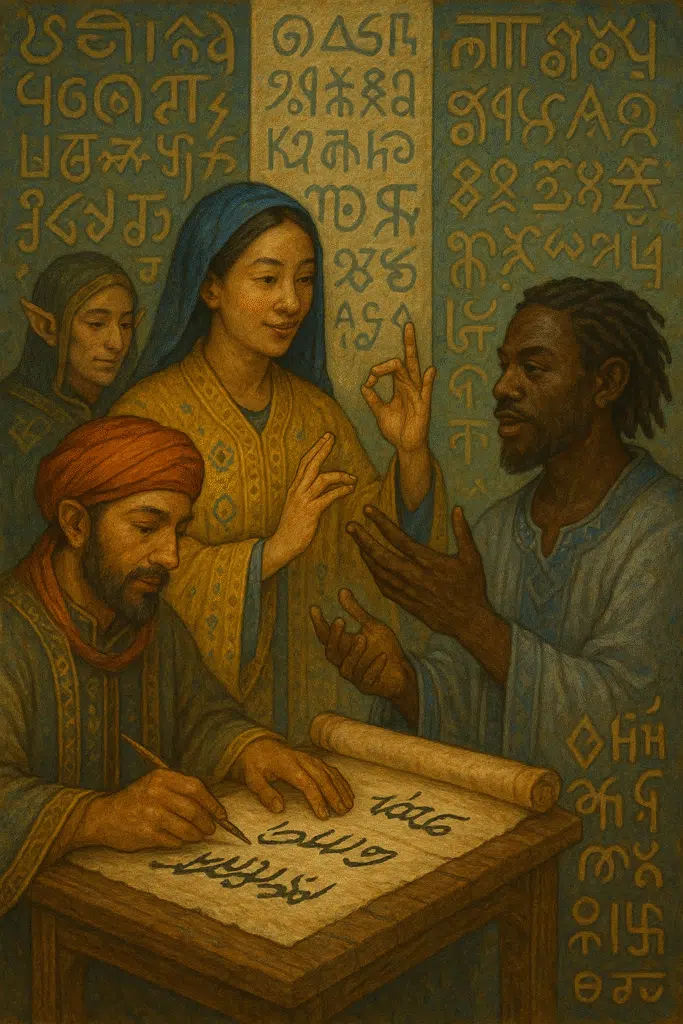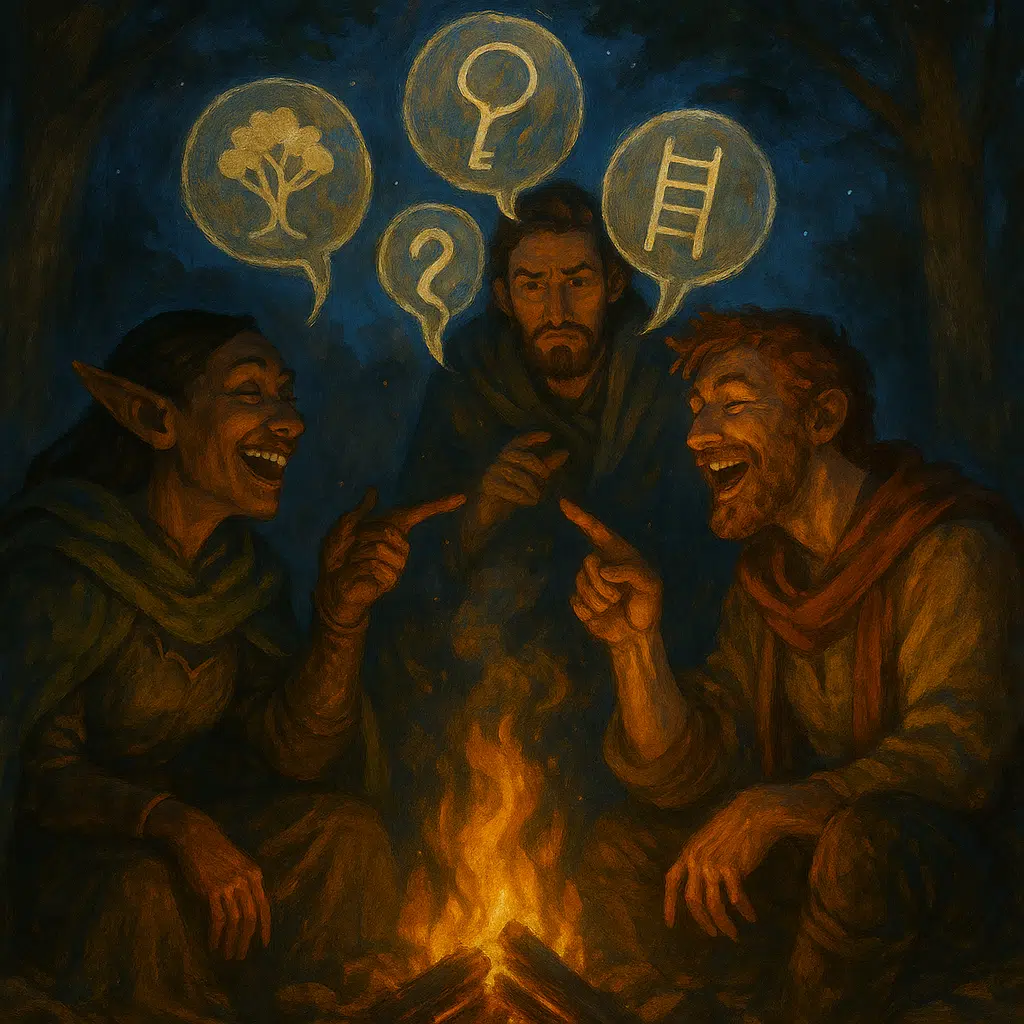Estimated Reading Time: 24 minutes (4524 words)
The knight draws his sword and declares, “Forsooth, milady, I shall smite thine enemies!” Your reader sighs and quietly closes your book. Another promising fantasy world lost to the graveyard of medieval clichés.
Dialogue is the living breath of your fictional world—when characters speak, they reveal not just plot points but entire cultures, belief systems, and personal histories. Yet many fantasy writers default to a strange linguistic territory that exists nowhere in reality: a jumbled mixture of Renaissance Faire theatrics, video game conventions, and modern speech patterns with “thou” awkwardly inserted.
Authentic fantasy speech isn’t about sprinkling archaic terms into otherwise contemporary dialogue. It’s about understanding how language emerges from culture, how speech reflects worldview, and how characters from different backgrounds would naturally express themselves within the reality you’ve created. When a desert nomad speaks of time as “sand falling through the glass of days,” we learn something profound about their world without a single exposition dump.
The most immersive fantasy worlds don’t just look different—they sound different. Their inhabitants speak in patterns that reflect their unique histories, magical understandings, and cultural touchstones. Their turns of phrase reveal power structures, spiritual beliefs, and technological developments that could never exist in our world. Their conversations carry the weight of your worldbuilding without readers even noticing it’s happening.
Creating authentic fantasy dialogue requires more than just sprinkling “thee” and “thou” throughout your manuscript. When characters speak in ways that reflect their world rather than ours, readers experience deeper immersion in your fantasy realm.
- Anchor dialogue in cultural worldbuilding: Characters should speak in ways that reflect their society’s values, history, and magical understanding. A character from a seafaring nation might use nautical metaphors even when inland.
- Create linguistic fingerprints for characters: Give each important character distinctive speech patterns, preferred expressions, or verbal tics that reveal their background without extensive exposition.
- Build vocabulary from your magic system: If magic shapes your world, it should shape your dialogue too. A fire mage might “spark with anger” while a water adept could “flow through problems.”
- Avoid the medieval European default: Fantasy worlds need not sound like Renaissance Faires. Develop speech patterns based on your unique cultures rather than defaulting to pseudo-Shakespearean dialogue.
- Replace modern idioms thoughtfully: Don’t just eliminate contemporary phrases—replace them with expressions that make sense within your world’s context. “Keeping your powder dry” wouldn’t work in a world without gunpowder.
- Balance authenticity with readability: Your dialogue should feel distinctive without becoming impenetrable. Readers shouldn’t need a glossary to follow basic conversations.
- Use dialogue to reveal power structures: How characters address each other can subtly show social hierarchies, magical ability rankings, or cultural tensions without explicit explanation.
Authentic fantasy dialogue emerges from thorough worldbuilding, not just archaic word choices. Let’s explore how to create speech patterns that feel genuinely rooted in your fictional realm while keeping readers engaged.
The Illusion of Otherworldly Speech
Why “ye olde English” fails fantasy readers
Fantasy dialogue often stumbles when writers reach for archaic-sounding language without understanding its historical context. Peppering conversations with “forsooth,” “prithee,” and “methinks” creates an immediate disconnect for readers. These terms weren’t used simultaneously or consistently even in historical periods, and combining them creates a linguistic hodgepodge that rings false.
The problem runs deeper than mere historical inaccuracy. When characters speak in this artificially antiquated way, they become caricatures rather than people. Their dialogue feels performative—as if they’re actors in Renaissance faire costumes rather than authentic inhabitants of their world. Readers sense this artificiality immediately.
Consider the difference between these approaches:
“Forsooth, milady, ’tis a fell beast that approacheth our humble abode!”
Versus:
“The shadows are wrong on that creature, Guardian. It isn’t natural to our valley.”
The first example strains to sound “fantasy-like” through outdated language. The second reveals character (the speaker’s observant nature), setting (a protected valley), and relationship dynamics (acknowledgment of the listener’s protective role) without resorting to linguistic shortcuts.
The hidden linguistic assumptions we make
We’re rarely conscious of the linguistic frameworks we impose on fantasy worlds. Most fantasy novels default to modern English syntax with a sprinkling of invented vocabulary, which creates an unacknowledged translation convention. We implicitly understand that characters aren’t actually speaking English—we’re reading a “translation” of their native tongue.
This convention becomes problematic when writers mix contemporary speech patterns with random archaisms or apply linguistic rules inconsistently. For example, a world where everyone uses “thou” and “thee” correctly would be one thing; a world where only wizards use these pronouns—and often incorrectly—creates cognitive dissonance.
Writers also frequently overlook how language reveals worldview. When a character from a society that has never developed timepieces says, “I’ll be back in a minute,” we glimpse the author behind the curtain. Similarly, Christian-derived expressions like “for heaven’s sake” or “thank God” in polytheistic or monotheistic fantasy worlds expose our cultural assumptions.
The most successful fantasy dialogue acknowledges these hidden assumptions and deliberately crafts speech patterns that arise organically from the imagined world, rather than imposing a pastiche of archaic or medieval-sounding language.

Rooting Dialogue in Cultural Foundations
When sailors speak on mountains
Characters bring their cultural background with them through their speech. A sailor transported to a mountain range wouldn’t suddenly adopt the terminology and metaphors of highland dwellers—their dialogue would remain saturated with nautical references, creating both authenticity and interesting character contrast.
Consider a ship’s navigator describing a mountain journey: “We’re veering too far west, into rougher terrain. We should tack northeast until we sight the river again.” The sailing terminology applied to land travel reveals the character’s background without exposition.
This principle extends to all professions and backgrounds. Blacksmiths might describe emotions in terms of metal properties (“His anger went from red-hot to tempered in seconds”). Farmers would reference seasons and growth patterns. Religious figures would incorporate theological concepts into casual conversation.
When writers neglect this aspect, we get the phenomenon of “fantasy bland”—characters who speak in generically modern voices despite vastly different cultural foundations. The result feels homogenized and fails to immerse readers in the world.
How trade, religion and geography shape everyday speech
A society’s trade relationships infuse its language with borrowed terms and concepts. A fantasy culture with extensive jade trade might incorporate jade-related metaphors throughout their speech: “smooth as jade,” “jade-minded” (for someone inflexible), or “Has jade dust clouded your eyes?” for questioning someone’s judgment.
Religion shapes language even more profoundly. In a world where the divine is categorized by elemental forces, everyday expressions might include:
“Fire and air preserve us!” “May earth hold your foundations steady.” “You’ve been touched by water’s wisdom.”
Geography creates natural dividing lines between dialects and influences metaphorical thinking. Desert dwellers might have fifty terms for sand types but struggle to describe forest phenomena. Island societies might conceptualize distance differently than continental ones. Mountain cultures often develop rich directional language—not just north/south but upslope/downslope, specific named winds, or references to prominent peaks.
When these elements combine in dialogue, they create the sense of a living, breathing world rather than a hastily painted backdrop. A mountain priest’s speech should differ recognizably from a coastal merchant’s not just in vocabulary, but in rhythms, metaphors, and conceptual framing.
Language as a Mirror of Power
Class distinctions in forms of address
Power structures inevitably shape language. In hierarchical societies, address forms become laden with significance. Rather than defaulting to generic “my lord” and “your highness” constructions, consider how your world’s specific power dynamics would influence speech.
A caste system might require subordinates to never use first-person pronouns when addressing superiors. A mercantile empire might replace noble titles with financial honorifics: “Thousand-Gold Merchant Raleth” or “Trade-Master Emberbright.” An age-based hierarchy might include birth year in formal address: “Elder-of-Sixty-Winters” or “Wisdom-of-Three-Decades.”
These systems become particularly revealing when characters challenge them. A rebellious youth in an age-hierarchical society might deliberately drop year references when addressing elders. A revolutionary in a caste society might provocatively use self-referential language forbidden to their station.
When characters cross cultural boundaries, these address forms become even more potent storytelling tools. A foreign diplomat struggling to navigate another culture’s complex honorifics reveals both societies’ values through their confusion and adaptation.
How magical hierarchies manifest in conversation
Magic systems create their own linguistic patterns and power dynamics. If magic requires formal education, practitioners might speak with academic precision and reference theoretical frameworks unintelligible to non-mages. If magical ability is inherited, family lineage terms might permeate magical discussion.
Consider how magic would affect everyday conversation even among non-practitioners:
In a world where enchantment is common, people might routinely ask, “Is that voiced?” when receiving written messages (asking if they contain audio enchantments).
Where weather magic exists, “uncalled rain” might distinguish natural precipitation from magically summoned storms.
Societies with mind-reading magic would develop conversational signals to indicate when spoken dialogue shifts to telepathic communication—perhaps specific gestures or phrases like “in silence, I add…”
The social status of magic users affects language bidirectionally. High-status mages might develop deliberately obscure terminology to maintain magical knowledge as exclusive. Low-status magic users might develop coded language to discuss forbidden practices while appearing to have ordinary conversations.
These linguistic patterns do more than add flavor—they reveal the actual functioning of your world’s power systems through natural conversation rather than exposition.

Beyond the Medieval European Default
Drawing inspiration from non-Western linguistic traditions
Western fantasy traditions have overwhelmingly drawn from medieval European linguistic patterns, limiting the richness of possible expressions. Languages like Chinese, with its lack of grammatical tense but complex honorifics, or Navajo, with its emphasis on verbs rather than nouns, offer alternative frameworks for fantasy dialogue.
Consider these non-Western linguistic features as inspiration:
- The Tamil distinction between inclusive and exclusive “we” (whether the speaker includes or excludes the listener in “we”)
- Japanese omission of subjects when they can be inferred from context
- Arabic’s tri-consonantal root system where related concepts share the same three-consonant backbone
- The extensive evidentiality markers in Quechua that indicate how the speaker knows the information (personal witness, hearsay, inference)
Applying these features thoughtfully creates distinctive dialogue without resorting to “ye olde English” clichés. A society inspired by evidentiality markers might have characters routinely add phrases like “by my eyes” (directly witnessed), “from trusted tongue” (reliable hearsay), or “through dream-sense” (magical/intuitive knowledge).
Creating fresh patterns without alienating readers
The challenge lies in creating distinctive speech patterns that remain readable. Too much linguistic innovation overwhelms readers; too little fails to establish authentic worldbuilding.
Effective approaches include:
- Consistent syntactic inversions: “Happy I am with this arrangement” rather than “I am happy with this arrangement”
- Cultural-specific confirmation patterns: “It is so, it is so” or “The path knows it” instead of simply “yes”
- Distinctive intensifiers: “frost-bitter cold” or “sand-vast distance” rather than “very cold” or “extremely far”
- Alternative question constructions: “You go to market, true-speaking?” rather than “Are you going to the market?”
The key is consistency. Choose a few distinctive patterns for each culture and apply them regularly rather than randomly sprinkling unusual constructions throughout dialogue. This allows readers to acclimate to speech patterns and eventually “hear” the distinctive voices without constant conscious processing.
Vocabulary Born from Your Magic System
When metaphors reflect magical understanding
A society’s understanding of magic inevitably shapes its everyday language. If magic operates on principles of equivalent exchange, concepts of balance and compensation would permeate ordinary conversation: “She’s balancing the scales” might mean someone is working to earn forgiveness, while “unaccounted debt” could refer to lingering resentment.
When magic systems tie into natural elements, weather terms gain additional significance. “Storm-minded” might describe someone with chaotic thoughts in a world where air magic influences mental clarity. “Her fire is banked” could indicate someone controlling powerful emotions in a society where fire magic connects to passion.
Even non-magical characters would use these references because the magical understanding of the world would be part of cultural knowledge. Farmers might say crops are “resisting the binding” rather than failing to thrive, reflecting a magic system based on connections and bindings.
These magical metaphors create a subtle sense of immersion without requiring explanation. They suggest that characters naturally think in terms of their world’s fundamental forces rather than our own.
Oaths and exclamations that reveal belief systems
Nothing exposes worldbuilding gaps faster than characters exclaiming “Oh my God!” in polytheistic fantasy worlds. Oaths and exclamations arise from what societies hold sacred, forbidden, or powerful.
In a world where blood magic is feared, “bloodless” might become an all-purpose negative exclamation. A culture valuing ancestor worship might exclaim “Forgotten names!” as their equivalent of “Good heavens!” A society where magic comes from stars might use “Unaligned stars!” or “Brilliant conjunction!” as expressions of surprise.
The most effective oaths connect to the stakes of your world’s belief systems. What do people fear? What do they revere? What forces do they believe influence daily life? Answers to these questions generate authentic exclamations:
“By the Unwritten Page!” (in a world where fate is conceptualized as an incomplete book) “Empty hands witness!” (where showing empty hands indicates honest intentions) “Seven streams preserve us!” (in a culture worshipping river deities)
These expressions do double duty: they sound authentic to the world while subtly informing readers about the belief systems that shape your characters’ understanding of the universe.

Creating Linguistic Fingerprints
Speech patterns that reveal character origins
Individual characters should speak in ways that reflect not just their personality, but their geographical and cultural origins. These linguistic fingerprints provide characterization without exposition and help readers distinguish between speakers.
Consider these distinguishing features:
- Sentence length and complexity: Characters from scholarly traditions might speak in complex, subordinate-heavy sentences, while those from warrior cultures might favor brief, direct statements.
- Question formation: Some characters might state questions with raised intonation rather than rearranging syntax.
- Pronoun usage: Characters from collectivist cultures might favor “we” and “our” even when speaking of personal matters.
- Word order preferences: A character might consistently place verbs at the end of sentences or always position adjectives after nouns.
These patterns become particularly useful for revealing backstory. A character who claims to be from the northern mountains but unconsciously uses coastal speech patterns creates immediate intrigue. A member of the royal court who occasionally slips into market district expressions hints at a hidden upbringing.
Verbal tics that bypass exposition
Character-specific verbal habits create instant recognition while revealing background and values. These might include:
- Distinctive hedging phrases: “Speaking through fog” or “if patterns hold true” rather than “probably” or “I think”
- Personal metaphor frameworks: A former sailor consistently uses nautical metaphors; a jeweler describes emotions in terms of gem properties
- Cultural parentheticals: “by the old counting” or “in market terms” when making comparisons
- Interruption and self-correction patterns: “No—wait—that’s not—let me speak plainly”
The key is consistency without overuse. Being too heavy-handed creates caricatures rather than characters. A subtle touch helps readers distinguish speakers without conscious effort.
Consider how a former temple scribe might regularly structure opinions as “The records would suggest…” while a mountain guide might frame certainties with “As sure as north-facing ice…” These habits reveal character history while creating memorable speech patterns.
The Art of Fantasy Idioms
Replacing modern expressions with world-appropriate alternatives
Modern idioms can shatter immersion in fantasy dialogue. Phrases like “not my cup of tea” or “barking up the wrong tree” connect directly to our world’s specific cultural contexts. However, simply removing all idiomatic language leaves dialogue flat and unnatural, as real speech relies heavily on figurative expressions.
The solution is crafting replacement idioms that emerge organically from your world’s history, environment, and cultural practices. Consider:
Instead of “beating a dead horse”:
- “Casting runes on cold ashes” (for a divination-based society)
- “Watering a stone tree” (for a desert culture)
- “Singing to the slaughtered” (for a culture with ancestor worship)
Instead of “the ball’s in your court”:
- “The stone awaits your carving” (for a sculpture-valuing society)
- “Your thread continues the pattern” (for a weaving-based culture)
- “The fire turns to your tending” (for hearth-centered communities)
Effective fantasy idioms maintain the same emotional and functional role as the expressions they replace while drawing imagery from the world you’ve created.
When characters misunderstand each other’s regional sayings
Idiomatic misunderstandings create organic moments for both humor and worldbuilding. When a desert dweller says someone “has sand in their thoughts” (meaning they’re practical and grounded) and a forest-born character takes it as an insult (assuming it means scattered thinking), we learn about both cultures through their linguistic confusion.
These misunderstandings are particularly effective for revealing cultural values. A mercantile society might use “weighs light” to mean something is worthless, while a spiritually-focused community might use the same phrase to mean something is transcendent or free from worldly concerns.
Conversations exploring these differences allow characters to share their worldviews naturally:
“You said she ‘speaks in winter voice.’ Where I’m from, that would mean she’s harsh or bitter.”
“No, no—in the mountains, winter voice is clear and carries far. It means she speaks truth that others will hear.”
These exchanges deepen both character relationships and world development while avoiding exposition that feels forced or unnatural.

Dialogue Across Cultural Boundaries
Language barriers as plot devices
Language differences create realistic friction in fantasy worlds where different cultures interact. Rather than having everyone conveniently speak the same language, consider the storytelling potential of partial understanding, translation difficulties, and linguistic misunderstandings.
Effective approaches include:
- Comprehension thresholds: Characters understand trades and basic directions but miss nuances in complex discussions.
- Partial translation: Including untranslated terms for concepts that don’t exist in the viewpoint character’s language.
- Interpreter characters who filter information through their own biases or deliberately mistranslate for personal gain.
- Magic that facilitates understanding but with limitations—perhaps literal translation without cultural context.
A character struggling with language barriers reveals vulnerability and creates authentic moments of connection when understanding is finally achieved. Consider how a diplomatic mission changes when a character catches a crucial mistranslation, or how relationships develop when characters teach each other their native expressions.
Code-switching between formal and familiar speech
Characters navigating different social contexts often alter their speech patterns—a phenomenon linguists call code-switching. A market vendor might use one dialect with customers, another with family, and a third when addressing officials.
This practice reveals character depth and social awareness. A character who skillfully code-switches between court language and street slang demonstrates adaptability and social intelligence. Conversely, a character who cannot or will not adjust their speech to circumstances reveals rigidity, privilege, or deliberate rebellion.
Code-switching creates particularly revealing moments when characters:
- Slip into their native dialect under stress despite trying to hide their origins
- Deliberately use inappropriate formality levels to establish boundaries
- Struggle to maintain formal speech patterns when emotionally overwhelmed
- Recognize another character’s origins through subtle speech markers others miss
These linguistic shifts provide organic opportunities to show rather than tell readers about social structures, character backgrounds, and relationship dynamics.
The Readability Balance
When authenticity conflicts with comprehension
Creating authentic fantasy dialogue requires balancing linguistic innovation with reader comprehension. Too much invented terminology, unusual syntax, or phonetic dialect spelling creates a barrier between reader and story. Too little makes the fantasy world feel like modern society in costume.
Effective techniques for maintaining this balance include:
- Front-loading distinctive patterns: Introduce unusual speech features early, then ease back once readers are acclimated.
- Contextual definition: Frame unfamiliar terms within explanatory context—”She drew her kilaj, the ceremonial blade all Raskari carry after their tenth summer.”
- Consistent but limited substitutions: Replace a few common terms with invented equivalents rather than creating entirely new vocabularies. For instance, consistently using “suncycle” instead of “day” establishes otherworldliness without requiring constant mental translation.
- Phonetic restraint: Suggest accents through word choice and syntax rather than spelling manipulations. Instead of “G’day, guv’na, ‘ows yer mum?” try “Good day to you, Governor. How fares your mother these days?”
The most successful fantasy dialogue creates the impression of reading a skilled translation—distinctive enough to evoke another world but fluid enough to remain engaging.
Creating distinction without constant translation
Readers quickly tire of explicit translations interrupting dialogue flow:
“Valkeri sun,” she said, which meant “good morning” in the local dialect.
More effective approaches embed meaning organically:
“Valkeri sun,” she said, tilting her face toward the rising light.
Or:
“Valkeri sun,” she greeted them. “The roads are clear all the way to the mountain pass.”
Repetition in varied contexts allows readers to absorb meaning without direct translation. When a term appears in multiple scenarios with consistent application, readers intuit meaning naturally—just as they would when traveling in a foreign country.
For core cultural concepts without direct English equivalents, consider having characters discuss or debate the term’s meaning. This creates natural worldbuilding while developing character relationships:
“The closest word in your tongue might be ‘honor,’ but sajaret is more than that. It encompasses one’s debt to ancestors and responsibility to descendants.”
These conversations deepen both world and character development while maintaining readability.

Avoiding Consistency Traps
When all your characters sound the same
One of the most common dialogue failures occurs when every character—regardless of background, education, or personality—speaks with the author’s voice. This homogeneity flattens characterization and wastes the worldbuilding potential of dialogue.
To avoid this trap:
- Create dialogue “fingerprints” for main characters—specific phrases, sentence structures, or verbal habits that distinguish their speech
- Develop distinct vocal patterns for different cultural groups, then modify these patterns for individual characters within those groups
- Consider each character’s relationship with language: Are they precise or flowery? Terse or verbose? Direct or circumspect?
- Track dialogue patterns deliberately, perhaps keeping a reference sheet of character-specific expressions and speech tendencies
A simple test: Remove dialogue tags from a conversation between main characters. If readers can’t identify who’s speaking based solely on language use, your character voices need stronger differentiation.
Maintaining voice through emotional scenes
Character voice often dissolves during highly emotional moments, when writers default to generic expressions of anger, fear, or joy. Yet these emotional peaks should reveal a character’s true linguistic nature, not obscure it.
A scholarly character might become more, not less, precise when angry—cold logic becoming their weapon. A character who normally uses flowery language might strip down to stark, broken sentences when grieving. A habitually formal character might reveal vulnerability through finally using contractions or familiar address forms.
These linguistic shifts during emotional scenes create powerful character moments when handled consistently. Consider how a character’s cultural background influences emotional expression—some societies encourage verbal processing of feelings while others value stoic restraint.
When characters break their established speech patterns, those moments should be deliberately significant. A character who never swears might use a single harsh expletive at a moment of extreme stress, creating impact precisely because it contrasts with their established voice.
Dialogue Evolution Over Time
How characters’ speech changes with experience
Static dialogue patterns waste character development opportunities. As characters journey through your story, their speech should evolve to reflect new experiences, relationships, and self-understanding.
Linguistic evolution might include:
- Adopting vocabulary from new cultures encountered during travels
- Gradually incorporating speech patterns from influential companions
- Shifting from uncertain, hedging language toward more confident assertions as skills develop
- Moving between formal and familiar address as relationships deepen
These changes should occur gradually rather than suddenly, with occasional backsliding during stress or uncertainty. A character might unconsciously revert to childhood dialect when injured or exhausted, revealing vulnerability through linguistic regression.
Dialogue evolution provides subtle but effective characterization. A young noble who initially speaks with rigid formality might gradually adopt street expressions after spending time with thief companions. This change demonstrates character growth more effectively than stating “she became more comfortable with her companions.”
Generational differences in fantasy societies
Just as real societies develop generational linguistic differences, fantasy cultures should display language evolution across age groups. Older characters might use obsolete terms or resist linguistic innovations, while younger characters adopt new expressions and challenge traditional speech conventions.
These differences reveal cultural change within your world. Perhaps younger merchants eliminate honorifics that older generations consider essential. Maybe temple youth incorporate street slang into ritual language, horrifying traditionalists. These tensions create authentic worldbuilding while providing natural conflict opportunities.
Generational speech patterns might reflect historical events within your timeline. Characters who lived through a great war might use distinctive metaphors or avoid certain terms that younger characters use freely. Those who remember a previous ruling dynasty might occasionally slip into now-forbidden address forms.
These linguistic fault lines create opportunities for both conflict and connection between generations while deepening your world’s historical texture.

Reading Aloud as Your Ultimate Test
Catching unnatural rhythms before publication
Dialogue that looks plausible on the page often reveals its weaknesses when spoken aloud. Reading dialogue aloud exposes awkward constructions, breaks in character voice, and rhythmic problems that silent reading might miss.
When reading aloud, listen for:
- Tongue-twister combinations that interrupt flow
- Unintentional rhymes or repetitive sentence structures
- Dialogue that requires unnatural breathing patterns
- Character distinctions that disappear when vocalized
- Consistency breaks in dialect or speech patterns
Pay particular attention to how dialogue sounds in extended conversation. While a single line might work in isolation, patterns of artificiality become apparent through extended exchanges. If your eyes start skimming during a dialogue section, readers’ will too—a sign that the conversation needs tightening or heightening.
For crucial scenes, consider recording yourself reading the dialogue and listening back. Distance from your own reading often reveals issues that reading alone might miss.
Dialogue performance as worldbuilding
Reading dialogue aloud not only tests its quality but also develops its connection to worldbuilding. Consider how different characters physically deliver their lines—do they gesture while speaking? Maintain intense eye contact? Touch the listener for emphasis? These physical components of communication reflect cultural norms and individual personality.
Some cultures might consider interruption rude while others see overlapping speech as enthusiastic engagement. Some might value lengthy pauses for consideration while others interpret silence as agreement or submission. These communication norms reveal as much about your world as vocabulary choices.
When reading dialogue aloud, consider:
- The pace at which different characters would speak
- Where they would place emphasis
- What gestures might accompany certain phrases
- How physical environment would affect delivery (whispers in temples, projections in marketplaces)
These performance elements, while not directly written into the text, influence how you construct dialogue and can be suggested through brief narrative descriptions that frame conversation. When dialogue feels authentic in performance, not just on the page, it creates truly immersive fantasy worlds where characters speak as products of their culture rather than as modern actors in period costume.
Words are magic in the truest sense—they create entire realities out of nothing but thought and air. When your characters speak from the authentic heart of their world rather than the borrowed conventions of ours, your readers don’t just visit your fantasy realm—they live there. The quest for genuine dialogue may require more effort than reaching for tired medievalisms, but the reward is a living, breathing world where every conversation carries the weight of history, culture, and possibility. Your characters’ voices, once liberated from the shackles of “forsooth,” become not just vehicles for plot but windows into souls shaped by worlds that have never existed—except in the shared imagination between writer and reader.






